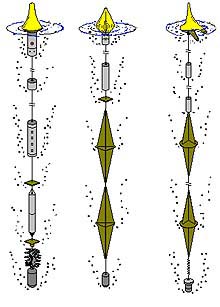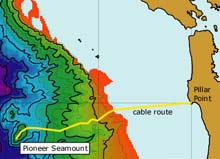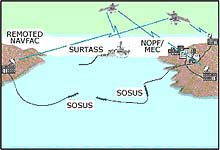
The SOund SUrveillance System, or SOSUS, consists of bottom-mounted hydrophone arrays connected by undersea communication cables to facilities on shore. (Illustration credit - Naval Research Laboratory). Click image for larger view.
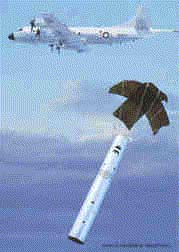
Sonobuoys can be launched from aircraft or surface ships. When launched from aircraft, a parachute deploys and helps to slow the sonobuoy's descent as it approaches the sea.
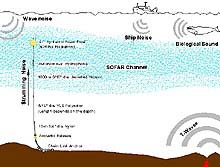
In 1996, NOAA’s PMEL laboratory developed autonomous moored hydrophones to augment fixed arrays, such as those of SOSUS. Click image for larger view and more information. Click image for larger view.
Technologies for Ocean Acoustic Monitoring
Chris Fox, Director
Acoustic Monitoring Project
NOAA Pacific Marine Environmental Laboratory
Just as microphones collect sound in the air, underwater hydrophones detect acoustic signals in the ocean. Most hydrophones are based on a special property (piezoelecticity) of certain ceramics that produce a small electrical current when subjected to pressure changes. When submerged in water, a ceramic hydrophone produces small-voltage signals over a wide range of frequencies as it is exposed to underwater sounds propagating from any direction. By amplifying and recording the electrical signals produced by a hydrophone, sound in the sea can be measured with great precision. Although a single hydrophone records sound arriving from any direction, several hydrophones can be simultaneously deployed in an array, and the resulting signals can then be manipulated to “listen” in any direction with even greater sensitivity than a single hydrophone element. Whether within an array or as a single element, the hydrophone is the basic sensor of underwater acoustics.
Currently, several technologies are available for acoustic exploration of the ocean. For decades, the U.S. Navy has used a device called a sonobuoy to record the sound of enemy submarines. This simple device can be deployed either from an aircraft or a surface ship. The sonobuoy includes a single underwater hydrophone and a radio transmitter to send the recorded signals back to the aircraft or ship. By deploying a pattern of sonobuoys, the location of the “target” can be determined. Sonobuoys have been used in ocean exploration as well, e.g., to record marine mammal calls and listen for earthquake activity, but the short life span of the device (a few hrs) prohibits long-term monitoring.
A much more expensive, but permanent, technology for acoustic exploration is the installation of a hydrophone array connected to an underwater communications cable. Since the 1960s, the U.S. Navy has operated such a SOund SUrveillance System (SOSUS) for military applications in many areas of the world ocean. With the fall of the Berlin Wall in 1989 and the end of the Cold War, the U.S. Navy offered the civilian scientific community “dual use” of SOSUS to evaluate its value in ocean environmental monitoring. Since 1991, NOAA has successfully used these arrays to detect submarine volcanic eruptions in the northeast Pacific and blue whale movements in the same area. The range of the system is such that volcanic tremors from south of Japan have been successfully detected and located using SOSUS arrays deployed off the coasts of Oregon and Washington. Access to SOSUS is restricted, both in the sense that the data are classified and can only be used in a secure facility, and also by the fact that the arrays are deployed only in areas of military need. The cabled nature of SOSUS allows real-time acquisition of the acoustic data, but at a high cost; the total investment in SOSUS is estimated at more than $16 billion.
Sonobuoys come in a variety of configurations. Above are examples of three deployed sonobuoys with floats at the surface and the ceramic hydrophone portions hanging in the water column. Click image for larger view.
This map shows the location of the submarine cable off the central California coast that is being used for the Sound in the Sea Project. This cable stretches from Pillar Point Air Force Station to an underwater seamount (Pioneer Seamount) and is approximately 100 km long. A passive underwater hydrophone will be installed on the seaward end of the cable. Data on recorded sounds will be sent along the cable to a station on land for processing, then made available over the Internet. Click image for larger view.
In the mid-1990s, NOAA developed portable hydrophones that can be deployed anywhere in the world ocean. This device consists of a single ceramic hydrophone attached to a water-proof “pressure case” that contains all of the batteries, computers, clocks, and other electronics required to maintain the hydrophone for several years. They have been used successfully in marine mammal studies and seismic studies, and have even been used to detect landslides on the south shore of Hawaii from a range of more than 5,000 km. These instruments have the advantage of portability; that is, they can be deployed anywhere in the world ocean, but cannot currently provide the data in real time; one must wait until a ship revisits the deployment site and recovers the instrument. Another advantage is that these instruments are relatively inexpensive compared to a cabled system such as SOSUS.
The Sound in the Sea Expedition to Pioneer Seamount offshore of California will install the first long-term cabled acoustic observatory in the deep ocean. During the 1990s, an expensive underwater cable was laid to Pioneer Seamount to conduct an oceanographic experiment that has since concluded. In support of ocean exploration, NOAA has assumed responsibility for the cable.
The Pioneer Seamount site offers the opportunity to install the first deep-water civilian hydrophone array for long-term monitoring of ambient ocean noises and their effects on the marine environment. The array will consist of four hydrophone elements suspended vertically in the water above the sea floor. The acoustic data will be collected at a small Air Force base in California, and, ultimately, will be accessible to both scientists and the public via the World Wide Web.
Sign up for the Ocean Explorer E-mail Update List.










